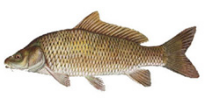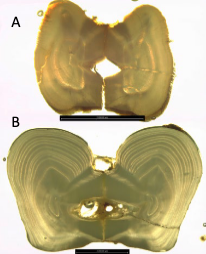By Siera Heiner, Rae Fadlovich
Does Carp Spine Readership Agreement Vary Between Juvenile and Adult Age Classes in Utah Lake?
Introduction
- Common carp (Cyprinus carpio, Figure 1) are one of the most widespread invasive fishes across the globe.
- Aging carp populations has considerable influence over fisheries management and provides insight on species’ life histories. 2
- High biomass of carp in Utah Lake negatively impact the ecosystem and inhibit threatened, endemic June sucker recovery.1
- Aging estimates are used to inform carp population models, so accurate carp ages are necessary for reliable models.
- By age 3, most carp in Utah Lake have reached spawning age. Understanding carp dynamics across life history stages (i.e., adult versus juvenile) helps inform population dynamics.
- As aging accuracy is the foundation of this conservation research, including carp control in Utah Lake, and it is imperative that readership agreement is acknowledged throughout aging processes.
- Our objective was to evaluate if readership agreement for Utah Lake
carp spines vary between juvenile carp and adult aged carp.
Methods
Carp Aging
- Preserved spines in epoxy to ensure the spines stayed intact then cut spines into thin cross sections using a saw.
- Spine samples were then mounted on a glass slides, imaged (Figure 2), and aged with respect to annulus counts.
Readership Agreement Analysis
- Spines were aged by three independent readers without prior knowledge of fish size or other readers’ estimates.
- Readership agreement for agers 1 and 2 when compared to the most experienced ager was calculated using FSA package in R following age bias plot methods in Ogle 2015.
- Percent agreement was calculated using the FSA package in R for both the juvenile age class (0-2) and the adult age class (3+) as described in Ogle 2015.
Age bias plots where points represent mean difference in estimated and experienced ages and lines represent 95% CI. The upper plot shows estimates of ager 1 and the lower plot shows estimates of ager 2.
Figure 3

Age bias plots where points represent mean difference in estimated and experienced ages and lines represent 95% CI.

The upper plot shows estimates of ager 1 and the lower plot shows estimates of ager 2.
Results
- McNemar symmetry was 16.6 for Ager 1 and 0.7 for Ager 2 (Figure 3).
- Overall percent agreement 45.31%.
- Percent agreement within the juvenile age class (ages 0-2) was 71.43% among all agers.
- Percent agreement within the adult age class (ages 3+) was 13.79% among all agers.

Common Carp.

Carp spine cross sections showing an age 1 carp with perfect agreement(A), and an age 13 carp where age estimates ranged from 11-13(B).
Conclusion
- Ager 1 demonstrated a directional bias, showing the potential to consistently under or overestimate carp age.
- Readership agreement was significantly higher within the juvenile age class than the adult age class.
- Uncertainty in adult aging can impact model estimates but has less impact on the model's usability for management decisions than juvenile age uncertainty.
- Future steps include creating an age-length key to estimate ages of Utah Lake carp based on their lengths.
References
- Walsworth, T.E., E. Wallace, and K. Landom. (2022). Common carp population response to ongoing control efforts in Utah
Lake. Ecology Center and Watershed Sciences Department, Utah State University, Logan, UT. - Vilizzi, L. (2018). Age determination in common carp Cyprinus carpio: history, relative utility of ageing structures, precision
and accuracy. Reviews in Fish Biology and Fisheries 28, 461–484. - Hoxmeier, R.J.H., Aday, D.D., and Wahl, D.H. (2001). Factors Influencing Precision of Age Estimation from Scales and Otoliths
of Bluegills in Illinois Reservoirs. North American Journal of Fisheries Management 21, 374–380. - Ogle, D.H. (2015). Introductory fisheries in R. CRC Press LLC..

